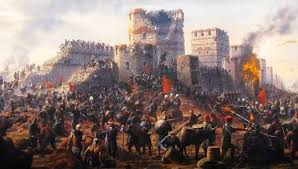World history is filled with events that not only shaped the course of human civilization but also continue to astonish us with their scale, impact, and sheer improbability. From miraculous recoveries to cataclysmic disasters, these events challenge our understanding of what is possible and offer profound insights into human nature and resilience. In this article, we delve into some of the most unbelievable events in world history that have left an indelible mark on our collective memory.
1. The Fall of Constantinople (1453)

1.1 The Context
The Fall of Constantinople marked the end of the Byzantine Empire and the rise of the Ottoman Empire. Constantinople, now Istanbul, was a city of immense strategic importance, serving as a bridge between Europe and Asia. Its fall had far-reaching consequences for trade, politics, and religion.
1.2 The Siege
In 1453, Sultan Mehmed II of the Ottoman Empire laid siege to Constantinople. Despite the city’s formidable defenses, including massive walls and a well-equipped navy, the Ottomans employed innovative tactics such as giant cannons and underground tunnels. The city’s fall was facilitated by internal dissent and a lack of reinforcements from Europe.
1.3 The Aftermath
The fall of Constantinople was a turning point in world history. It led to the end of the Byzantine Empire, reshaped trade routes, and contributed to the Age of Exploration as European powers sought new paths to Asia. The event also marked the rise of the Ottoman Empire as a dominant force in the region.
2. The Moon Landing (1969)
2.1 The Space Race
The Moon landing was the culmination of the Space Race between the United States and the Soviet Union during the Cold War. The desire to achieve this historic feat was driven by scientific curiosity, geopolitical competition, and the quest for technological supremacy.
2.2 Apollo 11 Mission
On July 20, 1969, Apollo 11 astronauts Neil Armstrong and Buzz Aldrin became the first humans to walk on the Moon. Armstrong’s famous words, “That’s one small step for man, one giant leap for mankind,” symbolized the achievement of a seemingly impossible goal. The mission demonstrated human ingenuity and perseverance, with over 400,000 people contributing to its success.
2.3 Legacy and Impact
The Moon landing remains one of the greatest achievements in human history, showcasing the potential of space exploration. It inspired generations of scientists, engineers, and dreamers, and it provided significant advancements in technology and international cooperation.
3. The Black Death (1347-1351)
3.1 The Plague’s Onset
The Black Death, also known as the Bubonic Plague, was one of the deadliest pandemics in human history. It swept through Europe, Asia, and Africa between 1347 and 1351, killing an estimated 75-200 million people. The disease was transmitted by fleas on rats and caused symptoms such as fever, chills, and buboes.
3.2 Societal Impact
The Black Death had a profound impact on European society. It led to labor shortages, economic upheaval, and a re-evaluation of societal and religious structures. The massive death toll also contributed to significant cultural and artistic shifts, including the development of macabre art and literature.
3.3 Modern Understanding
The study of the Black Death has provided valuable insights into epidemiology and public health. It also serves as a historical example of how pandemics can reshape societies and influence historical trajectories.
4. The Discovery of the Tomb of Tutankhamun (1922)

4.1 The Discovery
In 1922, British archaeologist Howard Carter discovered the nearly intact tomb of Pharaoh Tutankhamun in the Valley of the Kings, Egypt. The tomb had been hidden for over 3,000 years and contained a wealth of artifacts, including the famous gold mask of Tutankhamun.
4.2 Significance
The discovery of Tutankhamun’s tomb was unprecedented in its completeness. It provided invaluable insights into ancient Egyptian culture, religion, and art. The treasures found in the tomb captivated the world and led to a renewed interest in Egyptology.
4.3 The Curse of Tutankhamun
The discovery was also accompanied by the so-called “Curse of the Pharaohs,” with some claiming that those who entered the tomb would face misfortune. While most of these claims have been debunked, they contributed to the mystique surrounding the discovery.
5. The Great Wall of China
5.1 Construction and Purpose
The Great Wall of China is one of the most remarkable architectural feats in history. Stretching over 13,000 miles, it was constructed over several dynasties, with the most famous sections built during the Ming Dynasty. The wall was designed to protect China from invasions by nomadic tribes and to consolidate the empire’s borders.
5.2 The Wall’s Features
The wall is not a single continuous structure but a series of walls, watchtowers, and fortifications. It includes various materials and construction techniques, depending on the region and the time period. The Great Wall is a testament to ancient Chinese engineering and military strategy.
5.3 Cultural and Historical Impact
The Great Wall has become a symbol of China’s historical resilience and cultural heritage. It attracts millions of visitors annually and represents one of the most enduring symbols of human endeavor and strategic thinking.
6. The D-Day Invasion (1944)
6.1 The Context
The D-Day invasion, also known as Operation Overlord, was a pivotal moment in World War II. On June 6, 1944, Allied forces launched a massive amphibious assault on the beaches of Normandy, France, marking the beginning of the end of Nazi occupation in Western Europe.
6.2 The Invasion
Over 156,000 troops from the United States, United Kingdom, Canada, and other Allied nations landed on five beachheads. The operation involved extensive planning, deception strategies, and coordination among multiple military branches. Despite fierce resistance, the invasion succeeded and led to the liberation of France.
6.3 Historical Impact
D-Day was a turning point in World War II, contributing to the eventual defeat of Nazi Germany. It demonstrated the effectiveness of Allied cooperation and strategic planning and paved the way for the liberation of occupied Europe.
7. The Rise and Fall of the Berlin Wall (1961-1989)

7.1 The Berlin Wall’s Construction
The Berlin Wall was erected in 1961 by East Germany to prevent the mass emigration of East Germans to West Berlin. The wall symbolized the division between the communist Eastern Bloc and the capitalist Western nations during the Cold War.
7.2 The Wall’s Fall
On November 9, 1989, the Berlin Wall fell in a moment of dramatic political change. The fall was triggered by a series of events, including increasing public pressure and political reforms within the Eastern Bloc. The collapse of the wall marked the end of the Cold War and led to the reunification of Germany.
7.3 Symbolism and Legacy
The Berlin Wall remains a powerful symbol of the struggle for freedom and the triumph of democracy over authoritarianism. Its fall represented a significant shift in global geopolitics and the beginning of a new era of cooperation and integration.
Conclusion
These unbelievable events in world history showcase the dramatic twists and turns that have shaped our world. From the fall of empires to groundbreaking scientific achievements, they remind us of the remarkable and sometimes improbable nature of human history. Each event, with its unique context and consequences, contributes to our understanding of the complexities of human experience and the resilience of societies throughout the ages. As we continue to study and reflect on these moments, we gain deeper insights into our past and our potential for shaping the future.

